Writing direction index
This is an index of the all the writing systems on this site arranged by the direction in which they are written. Some writing systems can be written in a number of different directions, others were originally written in various directions but eventually settled on one direction.
Why some writing systems are written in one direction, and others in other directions is a bit of a mystery. It might have something to do with the writing surfaces and implements originally used, fashion, the handedness of the creators of the writing systems, or other factors.
If you have any information or theories about this, please contact me.
Directions
- Left to right, horizontal
- Right to left, horizontal
- Left to right, vertical
- Right to left, vertical
- Boustrophedon
- Variable
What is writing? | A-Z index | Language index | Site map
 Left to right, horizontal
Left to right, horizontal
The following writing systems are written from left to right in horizontal lines:
Ahom, Ancient Berber, Angelic, Armenian, Balinese, Bassa (Vah), Batak, Beitha Kukju, Benjamin Franklin's Phonetic Alphabet, Bengali, Blackfoot, Blissymbolics, Brahmi, Buhid, Burmese, Carrier, Celtiberian, Cham, Cherokee, Coptic, Cree, Cyrillic, Daggers, Dehong Dai/Tai Le, Deseret, Devanagari, Dhives Akuru, Elbsan, Enochian, Ethiopic, Fraser, Georgian (Asomtavruli), Georgian (Nuskha-khucuri), Georgian (Mkhedruli), Glagolitic, Gothic, Grantha, Greek, Gujarati, Gurmukhi (Punjabi), Hanuno'o, Hmong, Iberian (Southern), International Phonetic Alphabet, Inuktitut, Irish Uncial, Javanese, Kannada, Kayah Li, Khitan, Khmer, Kpelle, Jurchen, Lanna, Lao, Latin, Lepcha, Limbu, Linear A, Linear B, Loma, Lontara/Makasar, Malachim, Malayalam, Manpuri, Mayan, Modi, Naxi, Ndjuká, Ogham, Ojibwe, Old Church Slavonic, Old Permic, Oriya, Passing the River, Pitman Initial Teaching Alphabet, Pollard Miao, Quikscript/Read Alphabet, Ranjana, Redjang, Runic, Santali, Sharda, Shavian, Shorthand, Siddham, Sinhala, Solresol Somali, Sorang Sompeng, Sourashtra, Soyombo, Sutton SignWriting, Syloti Nagri, Tagalog, Tagbanwa, Tai Dam, Tai Lue, Tamil, Telugu, Thai, Theban Tibetan, Tocharian, Ugaritic, Unifon, Vai, Varang Kshiti Visible Speech, Yi
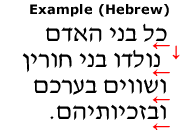 Right to left, horizontal
Right to left, horizontal
The following writing systems are written from right to left in horizontal lines:
Ancient Egyptian (Demotic), Ancient Egyptian (Hieratic), Ancient Egyptian (Hieroglyphic), Aramaic, Arabic*, Avestan, Chinese, Cypriot, Etruscan, Hebrew, Iberian (Northern), Kharosthi, Linear B, Old Italic, Orkhon, Mandaic, Mende, Meroïtic (Cursive), Middle Persian, Nabataean, N'Ko, Parthian, Phoenician, Proto-Elamite, Psalter, Sabaean, Samaritan, Sogdian, Tifinagh, Syriac, South Arabian, Thaana
*In Arabic numerals are written from left to right.
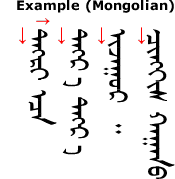 Left to right, vertical
Left to right, vertical
The following writing systems are written from left to right in vertical lines running from top to bottom:
Old Elamite, Manchu, Mongolian, Oirat Clear Script, Phags-pa, Sogdian, Uyghur
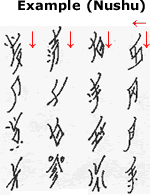 Right to left, vertical
Right to left, vertical
The following writing systems are written from right to left in vertical lines running from top to bottom:
Chinese, Chữ-nôm, Japanese, Korean, Meroïtic (Hieroglyphic script), Nushu, Tangut (Hsihsia)
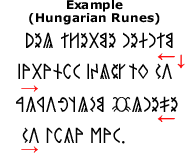 Boustrophedon
Boustrophedon
The following writing systems are written in horizontal lines running alternatively from right to left then left to right. This is called Boustrophedon, which comes from the Greek βους (bous) "ox" + στρεφειν (strefein) "to turn", because it resembles the path an ox makes when plowing field, turning at the end of each row to return in the opposite direction.
Hungarian Runes, Linear B, Rongo Rongo Sabaean
Variable
Ancient Berber
In inscriptions, Ancient Berber texts start either at the bottom left or bottom right and run upwards. Monumental inscriptions generally run in horizontal lines from right to left.
Ancient Egyptian (Hieroglyphic)
The Ancient Egytian Hieroglyphic script was written in any direction the was convenient: horizontally from right to left or left to right or vertically from top to bottom. The arrangement of the glyphs was partly determined by aesthetic considerations. When written horizontally, you can tell the direction of a piece of writing by looking at the way the animals and people are facing: they look towards the beginning of the line.

Source: http://hieroglyphs.net
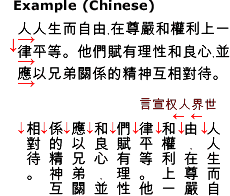 Chinese
Chinese
Chinese can be written from right to left in vertical columns, left to right in horizontal lines, or occasionally right to left in horizontal lines. In Taiwan it is often written in vertical columns, while in China it is usually written horizontally from left to right. In newspapers and magazines with vertical text, some of the headlines and titles are written horizontally right to left across the top of the main text.
Etruscan
Etruscan was sometimes written in boustrophedon fashion and sometimes from right to left in horizontal lines.
Japanese
Japanese can be written from right to left in vertical columns or left to right in horizontal lines.
 Korean
Korean
Korean can be written from right to left in vertical columns or left to right in horizontal lines.
Ogham
When inscribed on stones, Ogham was written around the edge starting at the bottom right and running upwards then back down the other side. In manuscripts it was written horizontally running from left to right.
Orkhon
Orkhon was written mainly from right to left in horizontal lines, though some inscriptions are written vertically with the letters rotated by 90º. When written vertically, it read from bottom to top and right to left.
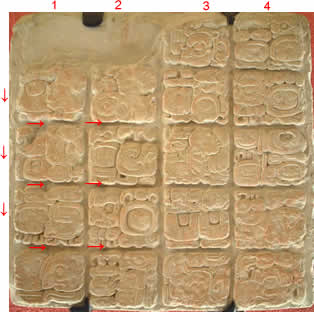
Mayan
In inscriptions, Mayan was written in paired columns zigzagging downwards from left to right. Any faces on the glyphs generally look towards the beginning of the line, as with Egyptian Hieroglyphs. Elsewhere it was usually written horizontally from left to right
The image on the left shows a Mayan inscription from the museum at Tonina in Chiapas, Mexico.
